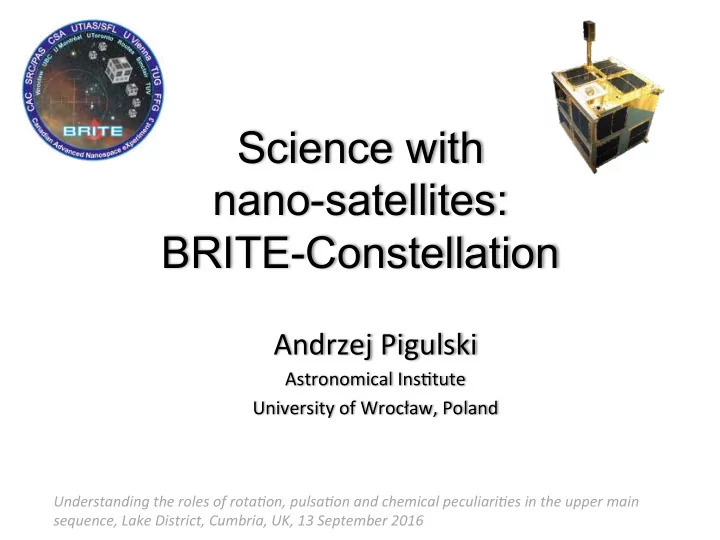

Science with nano-satellites: BRITE-Constellation Andrzej Pigulski Astronomical Ins6tute University of Wrocław, Poland Understanding the roles of rota0on, pulsa0on and chemical peculiari0es in the upper main sequence, Lake District, Cumbria, UK, 13 September 2016
Bright star photometry with nano-satellites Why bright stars? Photometry is difficult from the ground. • Easy or exis6ng (6me-series) spectroscopy. • Visual + SB2 orbits for binaries -> masses. • Accurate parallaxes. • Low ex6nc6on & reddening. • Why nano-satellites? • Small telescope = small satellite. • Low-cost. • Tes6ng new techniques.
BRITE BRI ght T arget E xplorer nanosatellite size: 20 × 20 × 20 cm mass: 7 kg telescope diameter: 3 cm launched: 2013-2014 Slavek Rucinski Scien6fic goal: variability of bright (luminous) stars Austria BRITE-Constella;on Canada 6 satellites, 3 equipped with red (R), 3 with blue (B) filter Poland
BRITE sky ≈ naked-eye sky
Pulsa;ng stars in the H-R diagram BRITE targets: Stars: - bright, - massive, - young. β Cephei SPB J.Christensen-Dalsgaard
BRITE-Constella;on Launch date In space for BRITE-Austria (BAb) 25.02.2013 43 months UniBRITE (UBr) 25.02.2013 43 months Lem (BLb) 21.11.2013 34 months Heweliusz (BHr) 19.08.2014 25 months BRITE-Montréal (BMb) 19.06.2014 27 months BRITE-Toronto (BTr) 19.06.2014 27 months R B
Field of view
Orion field
BRITE photometry UBr BAb • rasters, • defocusing, • aperture photometry. Images courtesy Rainer Kuschnig & Adam Popowicz
Rasters/windows, modes of observing Chopping mode Normal mode Pigulski et al. (2016) Popowicz et al. (2016)
Removing instrumental effects: an example Cen: HD 128898, BAb, 4 (α Cir)
Removing instrumental effect: an example BEFORE : ~150 days, two-colour AFTER:
BRITE sky
Summary of up-to-date observa;ons Heweliusz Lem Toronto UniBRITE BRITE-Austria Y E A R
Summary of the up-to-date observa;ons Observa6ons obtained for 14 fields ( 337 stars). Data delivered for 13 fields ( 300 stars). This includes 70% of all OB stars brighter than V = 4 mag. Ongoing observa6ons of 3 next fields. The associated spectropolarimetric survey (~ 500 stars, C.Neiner) Two technical papers published. The first three scien6fic papers published. Two papers submiied. Next 20 – 25 papers at different stages of prepara6on. BRITE-Constella6on Web page: hip://www.univie.ac.at/brite-constella6on/ BRITE-Constella6on Wiki page: hip://brite.craq-astro.ca/doku.php?id=start BRITE-Constella6on Facebook page: hips://www.facebook.com/briteconstella6on
Summary of the up-to-date BRITE targets
α Circini (HD 128898, A7 Vp SrCrEu, V = 3.19) P = 6.8 minutes Kurtz & Cropper (1981) Kurtz et al. (1981)
α Circini from WIRE pulsa6ons rota6on Bruni, Kurtz, et al. (2009)
α Circini from BRITE: rota;on Weiss et al. (2016)
α Circini from BRITE: pulsa;ons f 1 and f 7 (marginally) detected Weiss et al. (2016)
β Centauri (HD 122451 = Agena, B1 V + B + ..., V = 0.6) Pigulski et al. (2016) Aa – Ab system
β Centauri: A-B system 8.32 ± 0.50 (van Leeuwen 2007) e = 0.6 – 0.8 P orb = 125 – 220 lat ω = 150 – 240° A – B T 0 = 2024 – 2032 system Ω = 67 – 110° i = 118 - 130°
β Centauri: two massive components V rot sin i: Aa: 200 - 250 km/s Ab: 70 - 120 km/s (Ausseloos et al. 2006) Ground-based observa;ons: f 2 , f 3 or their aliases (spectroscopy) nothing reliable from photometry
β Centauri: BRITE, frequency spectrum 8 g modes 9 p modes 2 combina6ons another β Cep/SPB hybrid Pigulski et al. (2016)
β Centauri: BRITE, frequency spectra 1. f 1 & f 2 are intrinsic, f 3 = f 1 + f 2 , f 19 = f 1 + 2f 2 2. f 2 & f 3 are intrinsic, f 1 = f 3 − f 2 , f 19 = f 2 + f 3
β Centauri: BRITE, frequency spectra
β Lupi (HD 132058, B2 IV, V = 2.7) 15 g modes Cugier et al. (in prep.)
η Centauri (HD 127973, B1.5 Vne, V = 2.3) long-term variability, P ≈ 29.4 d Baade et al. (2016)
η Centauri (HD 127973, B1.5 Vne, V = 2.31) Štefl frequency, f S ≈ 1.556 d −1 Baade et al. (2016)
η Centauri (HD 127973, B1.5 Vne, V = 2.31) Frequency spectrum of residuals Δf f S 2 f S f 1 − f 2 = Δf Baade et al. (2016)
δ Pictoris (HD 42933, B0 III) BRITE data (Heweliusz) P orb = 1.67254 d
δ Pictoris (HD 42933, B0 III)
δ Pictoris (HD 42933, B0 III) Pulsa6ons originate in the primary star !
Conclusions 1 . BRITE data are as good as expected. Periodic variability with amplitudes down to 0.2 – 0.3 mmag can be detected. This proves that nano-satellites can be used for science. 2. BRITEs will allow asteroseismology of a large sample of Beta Cep/SPB stars with a significant number of modes (10 – 20). 3. Beta Cep/SPB hybridity seems to be widespread. 4. Observa6ons of a large sample of Be stars may bring a breakthrough in understanding the role of pulsa6ons in transferring maier to circumstellar disk. 5. Precise masses and radii of many massive stars will be determined.
Thank you, Don, for your excellent work and for inspiring many colleagues with new ideas. Have a lot of fun con6nuing work on stars... With best gree0ngs from (non-rapidly oscilla0ng) AP
Recommend
More recommend